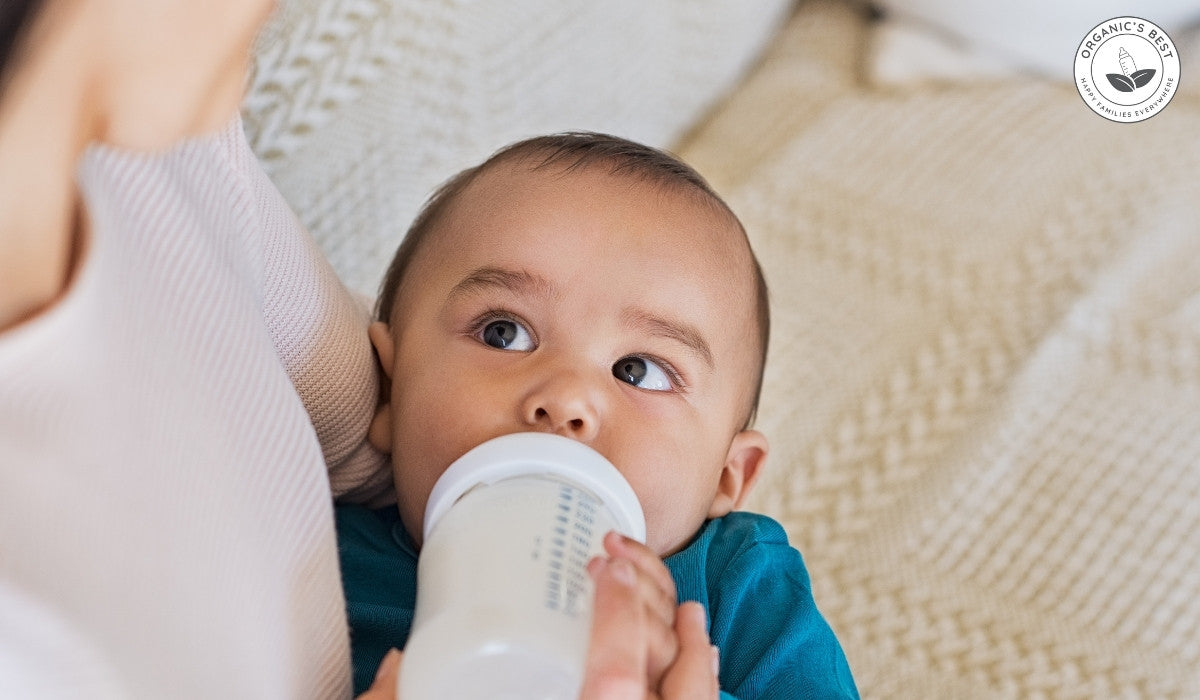Click to Get 2 FREE Boxes/Cans
Click to Get 2 FREE Boxes/Cans
Only New Customers! Click HERE to Get 2 Extra Boxes/Cans for Free With Your First Order.
Only New Customers! Click HERE to Get 2 Extra Boxes/Cans for Free With Your First Order.
BABY FORMULA
Offering new parents top-quality European infant formula from renowned brands like HiPP, Holle, Kendamil, and more. If you’re uncertain about which product to choose, our Formula Finder can help you make the best decision for your baby.
Baby Food
Offering new parents a premium selection of European baby foods, including jars, pouches, cereals, and snacks from esteemed brands like HiPP and Holle.
Perfect Your Bottle Game: Embrace the Art of Paced Feeding!
by Agustina Fernandez December 12, 2023 9 min read

Feeding your baby isn't just a meal—it's a bonding moment filled with love and trust. As parents, we cherish these intimate moments of nourishing our little ones, knowing that each interaction goes beyond satisfying their hunger.
In this article, we delve into the importance of adopting the right feeding technique, known as paced bottle feeding, in supporting your baby's well-being. We'll explore what paced bottle feeding is and why it's so crucial, and we'll provide you with essential guidance on how to execute it effectively.
So, are you ready to perfect your bottle game? Then keep reading!
Table of contents
- What is Paced Bottle Feeding?
- What are The Benefits of Paced Bottle Feeding?
- How Paced Bottle Feeding Newborn Supports Breastfeeding
- How to Begin Paced Feeding
- Mastering the Art of Burping When Paced Bottle Feeding
- Common Challenges in Paced Feeding and How to Overcome Them
- Problems with Pace Feeding: When to Consult a Professional
- FAQs about the Paced Bottle Feeding Technique
What is Paced Bottle Feeding?
Paced bottle feeding stands in stark contrast to the conventional method of bottle feeding. In traditional bottle feeding, the focus often lies on finishing the bottle quickly, with milk flowing steadily through the nipple. This can lead to the baby drinking more milk than necessary, potentially causing discomfort, overfeeding, and even issues like colic or gas.
According to the Minnesota Department of Health (PDF source), the pace feeding method involves slowing down the flow of milk into the nipple and the baby's mouth, enabling the infant to dictate the pace of the feed more like exclusively breastfed babies. In essence, paced bottle feeding is a gentle and responsive method that prioritizes the baby's comfort and well-being, emphasizing the importance of not just what they eat but how they eat.
Paced feeding, as opposed to traditional bottle feeding, promotes a more relaxed and baby-led approach. It reduces the risk of overfeeding by allowing the baby to pause, burp, and determine when they are satisfied, thus mirroring breast feeding more closely. This makes it an excellent choice for babies who transition between breast and bottle-feeding or those who are exclusively bottle-fed!
What are The Benefits of Paced Bottle Feeding?
A paced bottle-feeding method offers a multitude of benefits for babies that go far beyond just satisfying hunger. Here's a glimpse into why many caregivers opt for this gentle feeding method for their breast-fed baby or formula-fed babies:

Pace Feeding Reduces the Risk of Overfeeding and Gassiness
Paced bottle feeding ensures that babies can take breaks and pause during the feed, reducing the likelihood of overconsumption. This, in turn, helps prevent discomfort, gassiness, and the associated fussiness that can follow a traditional bottle feed.
Feeding Based on Baby's Hunger and Fullness Cues
With paced feeding, the emphasis is on your baby's feeding cues. They have the freedom to eat when they're hungry and stop when they're full, fostering a healthy relationship with food from an early age. In fact, research suggests that responsive feeding can help reduce obesity risk in childhood.
Smoother Transition Between Breast and Bottle Feeding
Paced feeding is especially advantageous for babies who switch between breast feeding and bottle feeding. It closely mimics the natural breast feeding experience, making it easier for babies to adapt to both methods seamlessly.
Learn More: Discover How to Supplement With Baby Formula
How Paced Bottle Feeding Newborn Supports Breastfeeding
There are many benefits of paced bottle feeding. One of the remarkable aspects of paced bottle feeding is its ability to complement and support breastfeeding in several ways. Here's how:
Oral and Facial Muscle Development
Paced feeding encourages bottle-fed babies to actively engage their oral and facial muscles to draw the nipple into their mouth and control the flow of milk. This is in contrast to traditional bottle feeding, where milk flow is primarily dictated by gravity. Paced bottle feeding can contribute to better oral motor development by strengthening these muscles.
Matching Breastfeeding Experience
Paced bottle feeding closely mirrors the natural breastfeeding experience, where babies need to work to extract milk. This similarity makes it less likely for babies to become accustomed to the faster nipple flow of a bottle and subsequently reject the breast. For breastfeeding mothers, this can be a crucial factor in maintaining a successful breastfeeding relationship.
How to Begin Paced Feeding
Now that we have covered what paced bottle feeding is, you're probably wondering how to implement this technique into your own feeding routine.
Here's a step-by-step guide on how to pace feed effectively:

Choose the Right Equipment: Opt for a small, 4 oz. bottle equipped with a slow-flow bottle nipple. These components are essential for controlling the milk flow.
-
Recognize Hunger Cues: Pay close attention to your baby's hunger cues. When you observe signs like rooting or mouth movements, gently tickle your baby's upper lip to encourage them to open their mouth wide.
-
Ensure a Deep Latch: Insert the nipple into your baby's mouth, ensuring they achieve a deep latch. A proper latch promotes efficient sucking and can help prevent babies from taking in lots of air.
-
Hold the Bottle Horizontally: Keep the bottle flat and parallel to the floor as your baby feeds. This ensures the nipple flow doesn't go too quickly and allows your baby to control the pace.
-
Start with Dry Sucking: Initially, allow your baby to actively suck on the nipple without any pumped milk or formula. This helps establish a rhythm and prepares your baby for the feed.
-
Introduce Milk Gradually: After a few dry sucks, usually around 10-15 seconds, tilt the bottle slightly to fill the nipple about halfway with milk. This controlled milk flow prevents overwhelming your baby.
-
Monitor Continuous Sucking: Encourage your baby to suck continuously for about 3-5 swallows, which typically lasts for 20-30 seconds.
-
Offer Breaks: After the 3-5 continuous swallows, gently tip the bottle downward, giving your baby a short break. This allows them to pause and breathe comfortably and not take in too much milk.
-
Observe Fullness Signs: Continue with the paced feeding method until your baby displays signs of fullness, such as no longer sucking after the break, turning away, or pushing the nipple away.
Optimize Milk Flow
When practicing paced bottle feeding, ensure formula or expressed breast milk is prepared following safe handling and storage guidelines provided by your pediatrician or formula manufacturer. We have a few simple tips to help make the experience smoother for both you and your baby. First, opt for a slow-flow nipple to maintain control over the milk flow. Frequent burping, especially at the end of the feeding, helps prevent discomfort.
Switch it Up
Additionally, don't forget to switch your baby to the opposite arm halfway through the feeding – not only does this promote healthy vision development, but it also adds a touch of variety to the feeding process.
Let Your Little One Lead
Lastly, it's perfectly fine if your baby doesn't finish the bottle; respecting their cues and appetite is key to the success of paced feeding.
How Does Paced Feeding Fit Into Overall Baby Care?
Paced feeding is not just a feeding technique; it's a fundamental element of holistic baby care. It embodies the principle of nurturing your baby's physical and emotional well-being during feeding and encourages healthy eating habits!

Mastering the Art of Burping When Paced Bottle Feeding
Burping your baby is an essential component of the paced bottle-feeding process, and it holds significant importance for your baby's comfort and well-being. When you practice paced bottle feeding, your baby may naturally swallow a bit of air along with their milk due to the controlled flow.
Burping helps release any trapped air bubbles, reducing the risk of gas and discomfort. It allows your baby to digest their meal more comfortably and minimizes the chances of colic or fussiness.
Practical Tips on How to Burp Your Baby Effectively
By incorporating these practical tips into your paced bottle feeding routine, you'll not only ensure your baby's comfort but also enhance the overall feeding experience:
• Timing Matters: Aim to burp your baby both during and after the feeding. Pausing midway through the feed to burp allows trapped air to escape, reducing the likelihood of excessive gas buildup.
• Choose the Right Position: Experiment with different burping positions, such as over the shoulder, on your lap, or sitting upright. Some babies may prefer one position over another, so find what works best for your little one.
• Support the Head: Regardless of the burping position you choose, ensure that you provide adequate head and neck support to your baby. Their neck muscles are still developing, and gentle support prevents any strain.
• Light Patting or Rubbing: Use gentle patting or rubbing motions on your baby's back to encourage burping. Start with a light touch, and if needed, gradually increase the intensity. Listen for any burping sounds or feel for air bubbles moving.
Read More: Why Your Baby Won't Burp and Techniques to Help
Common Challenges in Paced Feeding and How to Overcome Them
While the paced bottle feeding method offers numerous benefits, parents may encounter certain challenges when implementing this method.
Addressing Common Difficulties or Concerns Parents Might Face
Frustration with Paced Feeding: Some caregivers might find paced feeding initially frustrating, especially if they are used to traditional bottle feeding. It can take time to adjust to the slower pace and responsiveness required.
Baby's Impatience: Babies accustomed to faster milk flow from bottles may become impatient with paced feeding, leading to fussiness during the feed.
Baby Rejecting the Bottle: In some cases, babies who have become accustomed to the fast flow of bottles may initially reject paced feeding because it requires more effort.
Spillage and Mess: Paced bottle feeding can sometimes lead to breast milk or formula spills or leaks due to the horizontal bottle positioning and the controlled flow.
Providing Solutions and Tips to Overcome These Challenges
Gradual transition and consistency in your approach can help your baby adapt to the slower pace. You can also experiment with different nipple options and create a distraction-free environment for feeding. Burping as needed and using a bib or cloth to manage spills are practical solutions to common issues.
Ultimately, staying attuned to your baby's cues and preferences while seeking professional guidance when necessary can help ensure a successful and enjoyable paced bottle feeding journey.
Problems with Pace Feeding: When to Consult a Professional
If you encounter persistent difficulties with paced feeding, such as your baby refusing the bottle, excessive fussiness, or inadequate weight gain, it's crucial to reach out to a healthcare provider or a lactation consultant.
If you are transitioning between breast feeding and bottle feeding, any concerns about your baby's latch, milk transfer, or signs of nipple confusion should prompt a consultation with a lactation consultant. These experts possess the knowledge and experience needed to identify underlying issues and provide tailored solutions.
Finally, if your baby shows signs like vomiting, excessive gas, diarrhea, or signs of discomfort during paced bottle feeding, it's essential to consult a healthcare provider promptly. These symptoms may indicate underlying health issues that require attention and professional assessment.
FAQs about the Paced Bottle Feeding Technique
Here are a few answers to frequently asked questions about the paced bottle-feeding method, offering insights into its practice, duration, appearance, safety, and potential issues like gas!
What is the Paced Feeding Method?
Paced feeding is a bottle-feeding technique designed to mimic breastfeeding by slowing down the flow of milk into the bottle nipple and your baby's mouth. Paced feeding helps give babies more control over the feeding pace by giving them a chance to swallow and breathe, which can reduce overfeeding and promote better digestion.
During paced feeding, feeders hold the bottle horizontally, and the baby is fed in a semi-upright position, with pauses to mimic the natural breastfeeding pattern.
How Long Should Paced Bottle-Feeding Take?
A pace bottle-feeding session typically takes about 15-20 minutes, similar to a breastfeeding session. This duration allows the baby to recognize fullness cues, helping to prevent overfeeding and promoting healthy weight gain.
What Does Pace Feeding Look Like?
During paced feeding, the baby is held in an upright position, and the bottle of milk or formula is tipped just enough to fill the nipple with milk. As baby eats, the feeder pauses every few sucks to give the baby time to swallow and breathe during small breaks. The feeding session involves frequent breaks, and the baby is allowed to start and stop as they show signs of hunger and fullness.
Is Pace Feeding Safe?
Yes, paced bottle feeding is safe when done correctly. It's actually recommended by pediatric experts, especially for infants who are transitioning between breast and bottle-feeding or for those who are exclusively bottle-fed, as it supports healthy weight gain and digestion and can prevent feeding difficulties.
Does Paced Feeding Cause Gas?
Paced bottle feeding is less likely to cause gas compared to traditional bottle-feeding methods. Since the baby has more control over the flow of milk, they tend to swallow less air, reducing the chance of gas and discomfort. If paced feeding is causing gas, it might be necessary to evaluate the technique to ensure it's being performed correctly.
Conclusion
Paced bottle feeding is more than just a feeding technique; it's a nurturing approach to infant care that places your baby's well-being at the forefront. This method allows babies to control the pace of their feed, reduces the risk of overfeeding and discomfort, and supports a smoother transition between breast and bottle feeding. Now, it's time to embrace the journey of parenthood, perfect your bottle game, and enjoy every feeding moment with your little one!
Disclaimer:
Please be aware that this information is based on general trends in babies, and it is not medical advice. Your doctor should be your first source of information and advice when considering any changes to your child’s diet or feeding routine. Always consult your pediatrician before making any decisions about your child’s diet or if you notice any changes in your child. Breastfeeding is the best nutrition for your baby because breast milk provides your child with all the essential nutrients they need for growth and development. Please consult your pediatrician if your child requires supplemental feeding. |
Agustina Fernandez
Dr. Agustina Fernandez earned her medical degree from the prestigious Universidad Nacional de Córdoba, Argentina. With a deep-rooted passion for pediatrics, Dr. Fernandez is currently on the path to specializing in children's healthcare. Recently, she has delved into the vital field of infant nutrition. Her research interests include breastfeeding, infant formula, and baby food in little ones’ formative years. Dr. Fernandez's commitment to this area of study underscores her dedication to ensuring the health and well-being of children from their earliest days.
Leave a comment
Comments will be approved before showing up.
Also in Organic Infant Nutrition and Health Blog

10 Winter Activities for Kids and Toddlers
by Agustina Fernandez January 06, 2026 8 min read
Read More
How to Choose The Best Infant Formula: A Guide to EU Organic Formulas
by Agustina Fernandez January 05, 2026 14 min read
Read More
Best Formula for Breastfed Babies 2026 Guide
by Agustina Fernandez January 05, 2026 15 min read
Read More
Reviewed by Dr. Bardha Citaku, MD
-

Dr. Bardha Citaku: Medical Reviewer of Organic's Best Blog
Dr. Bardha Citaku completed her medical studies at the University of Prishtina in Kosovo, where she began her journey into the field of medicine. She has since developed a career in medical research, contributing to projects with notable organizations, including the World Health Organization (WHO).
